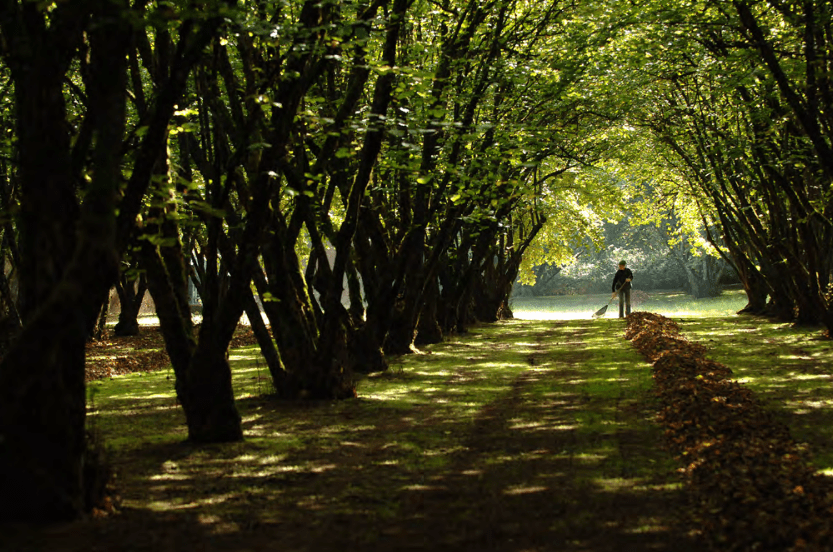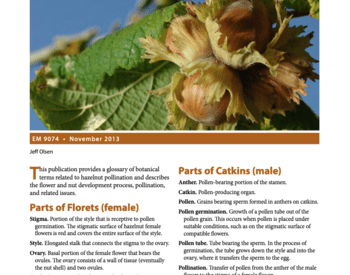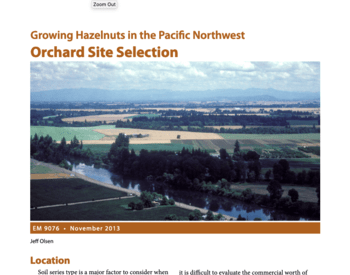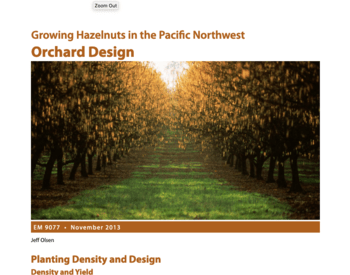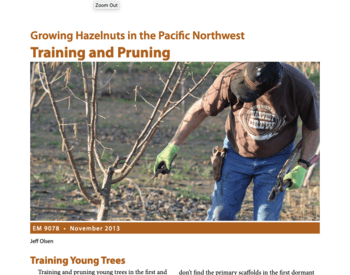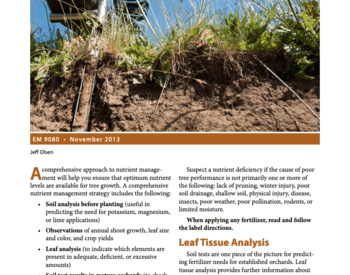Weed Management
A good herbicide program in the tree row and flailing (mowing) between rows provides the best protection against weeds. For specific, current weed management and sucker control recommendations, see Oregon State University Extension publication EM 8328 (Hazelnut Pest Management Guide for the Willamette Valley) or the current edition of the Pacific Northwest Weed Management Handbook (http://pnwhandbooks.org/weed). Herbicides registered for use change from year to year, and both of these publications are updated regularly.
Flailing
The no-till system of soil management, which uses flailing, is popular because it helps prepare the ground for harvest. Before you begin flailing or harvesting, the orchard floor must be smooth and even. Remove mounds of soil around tree trunks so you can run the harvest sweeper right up to the trunk. By flailing in two directions, you can avoid creating ruts. You may still need to use a leveling device and pull a float (rectangular metal frame) to smooth the orchard floor surface before harvest to fill in small depressions in the soil that harbor harvestable nuts.
Flail mowers mow weeds as close as ¼ inch from the soil surface. Flail mowing the orchard floor four to six times per season usually provides satisfactory weed control. Start flailing in spring as soon as the ground is dry enough to accommodate a tractor with wide, high-flotation tires without making ruts. This usually occurs in March before ground vegetation is 6 inches (15.2 cm) high. After the rains subside, winter annual weeds die, but the more competitive, drought-resistant summer weeds germinate and grow.
In flailed orchards, the potential for soil erosion is confined mainly to the herbicide-treated strip within the tree row. These strips should run across the slope rather than with the slope.
The earthworm population increases after flailing if soil moisture is preserved. Earthworm castings (excrement) can be a nuisance during harvest. However, the vertical tunnels that worms make greatly increase water penetration and drainage, so you can resume harvesting sooner after a heavy rain.
Herbicides
Read the labels carefully, and always apply herbicides according to label directions.
Some herbicides can be applied several weeks after planting, but others cannot be used near newly planted trees for the first year. Herbicides labeled for use in the first few years after planting are labeled as “nonbearing” and have a required 365-day preharvest interval (PHI)—the time from application to harvest. Some herbicides are excluded from use immediately after planting because they may penetrate young stems or leach into the soil and negatively affect root growth. Typically, labels require that the soil be allowed to settle around new transplants before the herbicide is applied.
In wet years, weeds might become so abundant that they prevent or hinder normal harvest operations. If you anticipate abundant weed growth the following year, apply a late-season, soil-residual herbicide to prevent weed germination.
Herbicide-resistant weeds are present in many Oregon crops, including hazelnuts. Glyphosate-resistant Italian ryegrass has been documented in several hazelnut orchards. This is mainly a result of repeated use of glyphosate for weed control in hazelnut orchards. Take the following steps to slow development of glyphosate resistance (these steps are generally applicable to preventing overuse of other herbicides as well):
1. Use nonchemical methods, such as cultivation, when possible.
2. Rotate herbicides or use herbicides with different modes of action. Herbicides are now assigned a mode of action group number, so you can choose different group numbers as a resistance management tool.
3. Use soil-residual herbicides. If you use glyphosate for general burndown, consider tank-mixing glyphosate with a preemergence herbicide.
4. Do not let weeds produce seed. Do not let annual ryegrass begin to flower and produce pollen.
5. If you use glyphosate, always use the higher labeled rates.
6. Apply glyphosate to small weeds. Glyphosate is always more effective on small weeds.
7. Ensure that you do not have hard water, which may impede glyphosate efficacy.
Preemergence herbicides can be very effective at reducing glyphosate resistance because they prevent weed seeds (which may have originated from weeds with partial resistance) from germinating and producing more seeds. However, most preemergence herbicides must be activated before they perform as expected. Herbicides are typically activated by rainfall or irrigation, and sometimes by tillage. The herbicide must also move into the soil surface before it becomes effective. Applying preemergence herbicides at the start of the winter rains or in the spring before rain ceases is the best way to ensure good efficacy. Many preemergence herbicides act as a barrier to emerging weeds, so it is important to keep the herbicide barrier intact. Soil disturbance will often break the soil barrier and allow weed seedlings to escape.
Intercropping
Growers sometimes plant another crop between the tree rows for the first few years after planting. When this intercrop is irrigated, tree growth can increase in the early years. Strawberries and beans are common intercrops in irrigated orchards.
In nonirrigated orchards, any intercrop can be detrimental to the growth of young trees, sometimes extremely so. Both the intercrop and weeds compete with the young trees for moisture. The result is poor growth and a relatively high rate of tree mortality.
Cover crops
For some orchards with erosion problems, annual winter cover crops can help prevent soil erosion. The cover crop slows runoff and aids penetration of rainfall or irrigation water. Cover crops also reduce the soil compaction caused by movement of vehicles in the orchard.
Some growers seed subterranean clover as a winter cover crop and mow it closely in spring. Where clover is planted, gophers tend to increase. Gopher control is especially important in an orchard planted with clover. Other good crops include Willamette vetch, hairy vetch, oats, winter wheat, and winter barley. Sow these crops immediately after nut harvest.
Managed native populations of subterranean clover or annual bluegrass also provide good cover. Sometimes there are enough volunteer weeds to serve as a cover crop. Use a selective herbicide to kill the broadleaf weeds in a volunteer cover crop.
Controlling Suckers
All hazelnut varieties produce suckers. Some herbicides are registered for hazelnut sucker control. Consult the Pacific Northwest Weed Management Handbook for specific recommendations. Spray suckers thoroughly before they are 6–9 inches (15.2–22.9 cm) tall. Spray suckers when needed from April through August, but no more than four times per year. Read the product label carefully, and follow the instructions.
Hazelnut Harvest
The Oregon hazelnut industry is a mature industry that has been around for more than 100 years. There are around 25 handlers to sell to and many receiving stations on farms that can help clean and dry the crop before you ship it to handlers for further processing. It is not necessary for growers to clean and dry their own crop, but some choose to build and operate the necessary equipment to accomplish that task.
Preparing the Ground for Mechanical Harvesting
Try to get the orchard floor as smooth as possible at least 1 year before the first commercial harvest. Dragging and floating the orchard floor lowers the high spots, but the loose soil that is pushed into the dips needs time to settle and become firm.
Nut Fall
Blank nuts fall before good nuts. After blanks have fallen and just before good nuts begin to drop (usually at the end of August), it might be desirable to do a final flailing and floating to fill small depressions in the ground. Light rain before harvest can help reduce dust and firm up the ground for harvesting. Make the orchard floor as smooth and firm as possible before harvest. This will allow you to adjust the height of the sweeper for maximum efficiency. This, in turn, helps minimize the amount of debris that ends up in the tote bins.
Windrowing Nuts
Before the pickup operation, sweep nuts into one or two windrows, each 2–4 feet wide (0.6–1.2 meters), between tree rows. Most growers have a sweeper with an attached leaf blower that moves the nuts away from the trees. Sweepers vary in size and cost. Sometimes sweepers are mounted on the front of a regular farm tractor. Most mechanical sweepers do such a good job of moving the nuts away from the tree row that additional handwork is not necessary.
The amount of leaves that fall before harvest is a major consideration in pickup operations. Try to avoid conditions that promote early leaf fall. Leaf fall occurs earlier in potassium-deficient orchards than in orchards with adequate potassium. Water stress, frost damage, and heavy aphid feeding also can cause early leaf drop.
In most years, it is October before all of the nuts have fallen naturally. Rain and windy weather bring down the last nuts but also create muddy conditions. Frost usually hastens nut drop. Most growers harvest multiple times because nuts fall over a period of time and weather conditions can shift during harvest from favorable to excessively wet.
For More Information
Many Oregon State University Extension publications on hazelnut production are available through the OSU Extension Catalog: http://catalog.extension.oregonstate.edu/
This information is provided for educational purposes only. If you need legal [or tax] advice, please consult a qualified legal [or tax] adviser.
Trade-name products and services are mentioned as illustrations only. This does not mean that the Oregon State University Extension Service either endorses these products and services or intends to discriminate against products and services not mentioned.
Use pesticides safely!
- Wear protective clothing and safety devices as recommended on the label. Bathe or shower after each use.
- Read the pesticide label—even if you’ve used the pesticide before. Follow closely the instructions on the label (and any other directions you have).
- Be cautious when you apply pesticides. Know your legal responsibility as a pesticide applicator. You may be liable for injury or damage resulting from pesticide use.
© 2018 Oregon State University.
Extension work is a cooperative program of Oregon State University, the U.S. Department of Agriculture, and Oregon counties. Oregon State University Extension Service offers educational programs, activities, and materials without discrimination on the basis of race, color, national origin, religion, sex, gender identity (including gender expression), sexual orientation, disability, age, marital status, familial/parental status, income derived from a public assistance program, political beliefs, genetic information, veteran’s status, reprisal or retaliation for prior civil rights activity. (Not all prohibited bases apply to all programs.) Oregon State University Extension Service is an AA/EOE/Veterans/Disabled.

